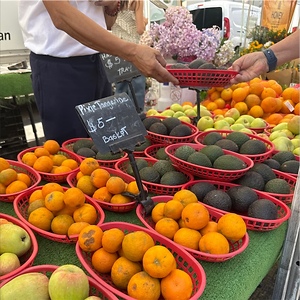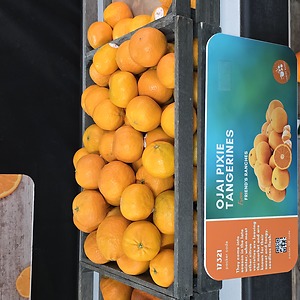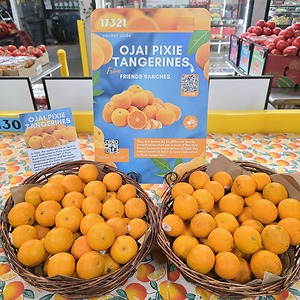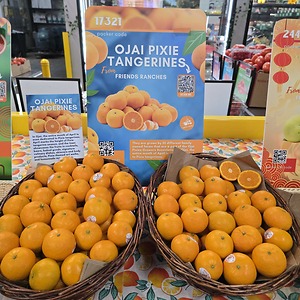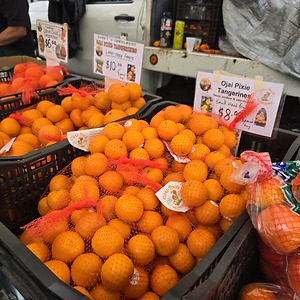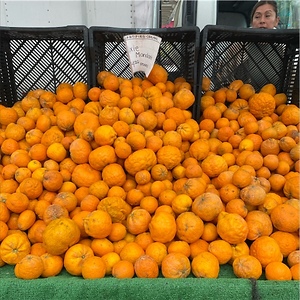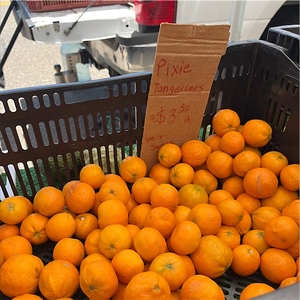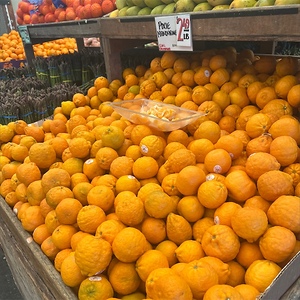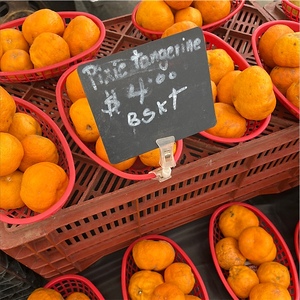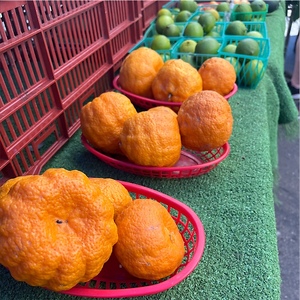

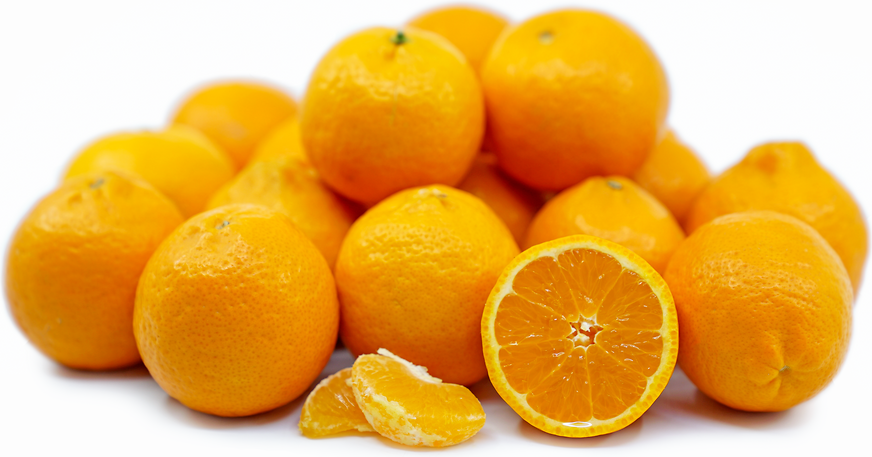
Pixie Tangerines
Estimated Inventory, 25 lbs : 0
Description/Taste
Pixie tangerines are a small variety, averaging 2 to 8 centimeters in diameter, and have a round to slightly oblate shape with a flat bottom. The thin rind ranges in color from pale orange to orange-yellow and bears a smooth to bumpy texture, covered in prominent oil glands that release fragrant essential oils. The rind is loosely attached, easily peeled, and reveals 7 to 8 segments of flesh divided by thin membranes. The orange flesh is aqueous, tender, and seedless. Pixie tangerines are aromatic and low in acid, creating a sweet, sugary taste balanced with a zesty, mild tang.
Seasons/Availability
tangerines are available for a short season in the late winter through spring.
Current Facts
Pixie tangerines, botanically classified as Citrus reticulata, are a small, late-season variety belonging to the Rutaceae or citrus family. The specialty citrus comes into season in the late winter, when most other citrus varieties are leaving the market and are known for their sweet and tangy, seedless flesh. Pixie tangerines are also known as Pixie mandarins and were first released to growers in the 1960s. The fruits were initially ruled as a home garden variety and were not viewed as a commercial cultivar due to their challenging cultivation requirements. Pixie tangerine trees take approximately 7 to 8 years to produce fruit and are alternate bearing, only growing large crops every other year. On average, 1 out of 400 blossoms turn into harvestable fruits, and the fruits must mature and survive on the trees for almost a year before they are picked. Despite their complicated nature, a small group of citrus growers in Ojai, California, began promoting the variety, eventually turning the fruits into a farmer’s market specialty cultivar throughout California. Each season, the fruits are highly sought after among citrus enthusiasts for their flavor, size, and seedless, easily segmented nature and are utilized in culinary applications, mixology, and cosmetics.
Nutritional Value
Pixie tangerines are an excellent source of vitamin C to reduce inflammation, strengthen the immune system, and boost collagen production within the skin. The small fruits are also rich in vitamin A to maintain healthy organ functioning and contain potassium to balance fluid levels, fiber to stimulate the digestive tract, and lower amounts of phosphorus, folate, calcium, and magnesium.
Applications
Pixie tangerines have a sweet and tangy flavor well-suited for both raw and cooked applications. The fruits are easily peeled, popularly consumed as a snack, and the segmented pieces can be tossed into salads or mixed into fruit bowls. Pixie tangerines can also be used as a fresh topping over yogurt, grain bowls, cakes, and tarts, or they can be blended into smoothies for added sweetness. The fruit’s juice is frequently combined into vinaigrettes, marinades, syrups, jams, and sauces, and the rind and juice are also used as a flavoring in cookies, cakes, muffins, custards, and gelato. Pixie tangerines pair well with fruits such as strawberries, bananas, blueberries, honey, broccoli, fennel, meats such as pork, poultry, turkey, and fish, other seafood, and herbs, including mint, basil, and rosemary. Fresh Pixie tangerines will keep for 2 to 3 weeks when stored in the refrigerator.
Ethnic/Cultural Info
Pixie tangerines are strongly associated with the Ojai Valley in Southern California. Often labeled as Ojai Pixie tangerines, the small fruits are grown by 52 different family-owned farms that are a part of the Ojai Pixies Growers Association. Pixie tangerines were initially planted in the Ojai Valley in the mid-20th century through a partnership between farmers Jim Churchill, Tony Thacher, Mike Shore, and Bob Davis. Each grower planted several hundred trees and believed the sweet, tangy fruits would one day be a favored late-season cultivar. Pixie tangerines were slow to be accepted by California consumers as many did not think a tangerine could contain quality flavors when sold outside of the traditional citrus season. As a result, the Ojai growers extensively marketed and sampled the tangerines up and down the California coast, eventually catching the attention of famous Chef Alice Waters and local school districts for cafeteria lunch fruits. In the present-day, Pixie tangerines are favored for their seedless flesh and sweet, juicy flavor, and the fruits that are grown in Ojai, a region with dry, hot summers and mild winters, are the most sought-after fruits among chefs and citrus enthusiasts. In Ojai, the entire month of April is even dedicated to Pixie tangerines. April marks the height of Pixie tangerine season, and the town showcases the fruits in cocktails, beers, baked goods, signature culinary dishes, skincare and body products, Pixie-themed art walks, and homemade marmalades.
Geography/History
Pixie tangerines were developed in 1927 at the University of California Citrus Research Center, Riverside. Breeder Howard B. Frost created the fruits from an open pollination cross between dancy and king mandarins to make a sweet, seedless variety. Pixie tangerines were released to commercial markets in 1965 through the efforts of Frost’s colleagues Robert K. Soost and James W. Cameron. The small fruits grow well in warm, Mediterranean climates with mild winters and are cultivated through small farms and home gardens in California and Florida. The Ojai Valley in Southern California has the largest concentration of Pixie tangerine growers, first planted in the 1960s, and the region is nationally known for producing quality fruits. When in season, Pixie tangerines can be found through farmer’s markets, specialty grocers, and select supermarkets across the United States.
Recipe Ideas
Recipes that include Pixie Tangerines. One



